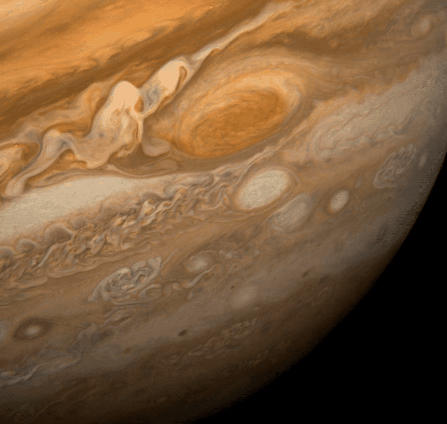Astronomy Picture of the Day
Discover the cosmos!
Each day a different image or photograph of our fascinating universe is
featured, along with a brief explanation written by a professional
astronomer.
August 3, 1996

Jupiter's Colourful Clouds
Credit:
Voyager Project,
JPL, and
NASA
Explanation:
What makes
the colours in Jupiter's clouds? With a mean temperature of
120 degrees Kelvin (-153 degrees Celsius)
and a composition dominated by
Hydrogen (about 90%), and Helium
(about 10%) with a smattering
of hydrogen compounds like methane and ammonia, astronomers have
been hard pressed to explain the blue, orange and brown cloud bands and
the salmon coloured "red" spot.
Trouble is -- at the cool
cloud temperatures
Jupiter's atmospheric constituents should be colourless!
Some suggest that more colourful hydrogen compounds well up from
warmer regions in the atmosphere, tinting the cloud tops.
Alternatively, compounds of trace elements like sulfur may colour the clouds.
The colours do indicate the clouds' altitudes, blue is lowest through
red as highest.
The dark coloured
bands are called belts and the light coloured ones zones.
In addition to the belts and zones, the Voyager missions revealed
the presence of intricate vortices visible, for example,
in this 1979
image from the Voyager I flyby.
Centuries of visual observations
of Jupiter have revealed that the colours of its clouds are ever changing.
Tomorrow's picture: NGC 3393: A Super Spiral?
<
Archive
| Index
| Search
| Calendar
| Glossary
| Education
| About APOD
>
Authors & editors:
Robert Nemiroff
(MTU) &
Jerry
Bonnell (USRA)
NASA Technical Rep.:
Jay Norris.
Specific rights apply.
A service of:
LHEA
at
NASA/
GSFC
&:
Michigan Tech. U.
